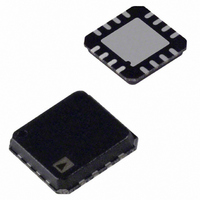AD7873BCP Analog Devices Inc, AD7873BCP Datasheet - Page 18

AD7873BCP
Manufacturer Part Number
AD7873BCP
Description
IC ADC 12BIT TOUCHSCREEN 16LFCSP
Manufacturer
Analog Devices Inc
Type
Resistiver
Datasheet
1.AD7873ACPZ-REEL.pdf
(28 pages)
Specifications of AD7873BCP
Rohs Status
RoHS non-compliant
Touch Panel Interface
4-Wire
Number Of Inputs/keys
1 TSC
Resolution (bits)
12 b
Data Interface
Serial
Data Rate/sampling Rate (sps, Bps)
125k
Voltage Reference
External, Internal
Voltage - Supply
2.2 V ~ 5.25 V
Operating Temperature
-40°C ~ 85°C
Mounting Type
Surface Mount
Package / Case
16-LFCSP
Voltage Supply Source
Single Supply
Sampling Rate (per Second)
125k
AD7873
PEN INTERRUPT REQUEST
The pen interrupt equivalent circuitry is outlined in Figure 33.
By connecting a pull-up resistor (10 kΩ to 100 kΩ) between +V
and this CMOS logic open-drain output, the PENIRQ output
remains high normally. If PENIRQ is enabled (see Table 8), when
the touch screen connected to the AD7873 is touched by a pen
or finger, the PENIRQ output goes low, initiating an interrupt to
a microprocessor. This can then instruct a control word to be
written to the AD7873 to initiate a conversion. This output can
also be enabled between conversions during power-down (see
Table 8), allowing power-up to be initiated only when the
screen is touched. The result of the first touch screen coordinate
conversion after power-up is valid, assuming any external
reference is settled to the 12-bit or 8-bit level as required.
Figure 34 assumes that the PENIRQ function was enabled in
the last write or that the part was just powered up so PENIRQ is
enabled by default. Once the screen is touched, the PENIRQ
output goes low a time t
5 μs, assuming a 10 nF touch screen capacitance, and varies
with the touch screen resistance actually used. Once the START
bit is detected, the pen interrupt function is disabled and the
PENIRQ cannot respond to screen touches. The PENIRQ
output remains low until the fourth falling edge of DCLK after
the START bit is clocked in, at which point it returns high as
soon as possible, irrespective of the touch screen capacitance.
This does not mean that the pen interrupt function is now
enabled again because the power-down bits have not yet been
loaded to the control register. Regardless of whether PENIRQ is
to be enabled again, the PENIRQ output normally always idles
high. Assuming the PENIRQ is enabled again as shown in
PENIRQ
PEN
DCLK
TOUCHED
SCREEN
DIN
CS
HERE
later. This delay is approximately
t
PEN
PROCESSOR
INTERRUPT
(START)
S
1
A2
Figure 34. PENIRQ Timing Diagram
A1
Rev. E | Page 18 of 28
A0
CC
NO RESPONSE TO TOUCH
MODE SER/
DFR
Figure 34, then once the conversion is complete, the PENIRQ
output again responds to a screen touch. The fact that PENIRQ
returns high almost immediately after the fourth falling edge of
DCLK means the user avoids any spurious interrupts on the
microprocessor or DSP, which can occur if the interrupt request
line on the micro/DSP were unmasked during or toward the
end of conversion and the PENIRQ pin was still low. Once the
next start bit is detected by the AD7843, the PENIRQ function
is again disabled.
If the control register write operation overlaps with the data
read, a start bit is always detected prior to the end of
conversion, meaning that even if the PENIRQ function is
enabled in the control register, it is disabled by the start bit
again before the end of the conversion is reached, so the
PENIRQ function effectively cannot be used in this mode.
However, as conversions are occurring continuously, the
PENIRQ function is not necessary and is therefore redundant.
1
0
8
TOUCH
SCREEN
1
Figure 33. PENIRQ Functional Block Diagram
Y+
Y–
X+
13
PD1 = 1, PD0 = 0, PENIRQ
ENABLED AGAIN
ON
+V
PENIRQ
ENABLE
16
CC
PENIRQ
100kΩ
+V
CC
EXTERNAL
PULL-UP












